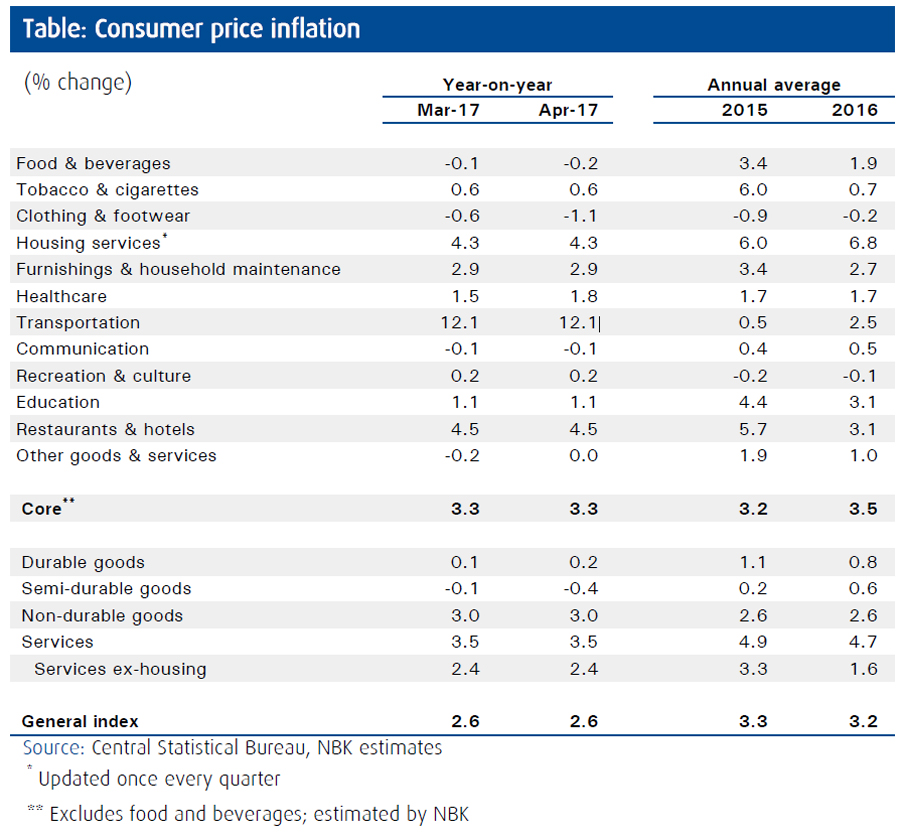 Click to view larger
Click to view largerKUWAIT: Inflation in consumer prices held steady at 2.6 percent year-on-year (y/y) in April, as inflation across most components stabilized. Softer inflation in housing rent has been a key contributor to lower inflation recently, as has food inflation. Local food prices continued to fall amid an ongoing decline in global food prices. Core inflation, which excludes food prices, also came in unchanged from March at 3.3 percent y/y.
Inflation is expected to gather some pace from the second half of 2017 onward, as the government hikes electricity and water tariffs. The tariffs are set to rise to 3-5 fils per kilowatt-hour (kWh) for the various sectors from the current 2 fils. In May, the Ministry of Electricity & Water began applying new utility tariffs in the commercial sector. Tariffs rose to 5 fils/kWh from 2 fils and to KD 2 per 1,000 imperial gallon of water from KD 0.8. The increases in utility prices are expected to push inflation up slightly from current levels to an expected annual average close to 3 percent in 2017; this is slightly lower than the 3.2 percent reading in 2016.
Inflation in food prices remained soft in April. Local food prices fell by 0.2 percent y/y as global food prices declined sharply. According to the Commodity Research Bureau, international prices of commodity foods were down by 8.4 percent y/y in April. Inflation in local food prices may face some limited upward pressure during Ramadan in May and June, when demand for some food staples typically rises. Indeed, a number of local co-ops have already hiked some prices by 20 percent to 35 percent.
Housing inflation
Inflation in housing services came in unchanged from March. Inflation in the housing component, mostly comprised of housing rents and updated quarterly, slowed from 6.4 percent y/y in 4Q16 to a three-year low of 4.3 percent y/y in 1Q17, in-line with some softness in the housing market. However, we expect momentum in this segment to pick up in the second half of 2017 on the back of higher utility tariffs.
Inflation in the retail sector remained weak amid subdued consumer demand. Inflation in clothing & footwear prices fell deeper into deflationary territory in April after retreating by 1.1 percent y/y, as the ongoing weakness in consumer demand continues to lead to more frequent and extended promotions. Car prices also continued to decline for the seventh consecutive month in April, after falling by 1.3 percent y/y. Inflation in "other goods & services" was flat amid softer gold inflation, while inflation in the furnishings & household maintenance segment was stable at 2.9 percent y/y.
Inflation in services was steady at a multi-month high of 2.4 percent y/y in April. Price growth remains particularly strong in the hospitality sector. At 4.5 percent y/y, inflation in the restaurants & hotels segment remained relatively elevated. Inflation in the services ex-housing has also been buoyed by the recent increases in transport service fees. Transport services have been readjusting their fees to account for the higher fuel charges that were implemented back in September of 2016. In April, inflation in this segment stood at a multi-year high of 3.3 percent y/y.
NBK ECONOMIC REPORT










